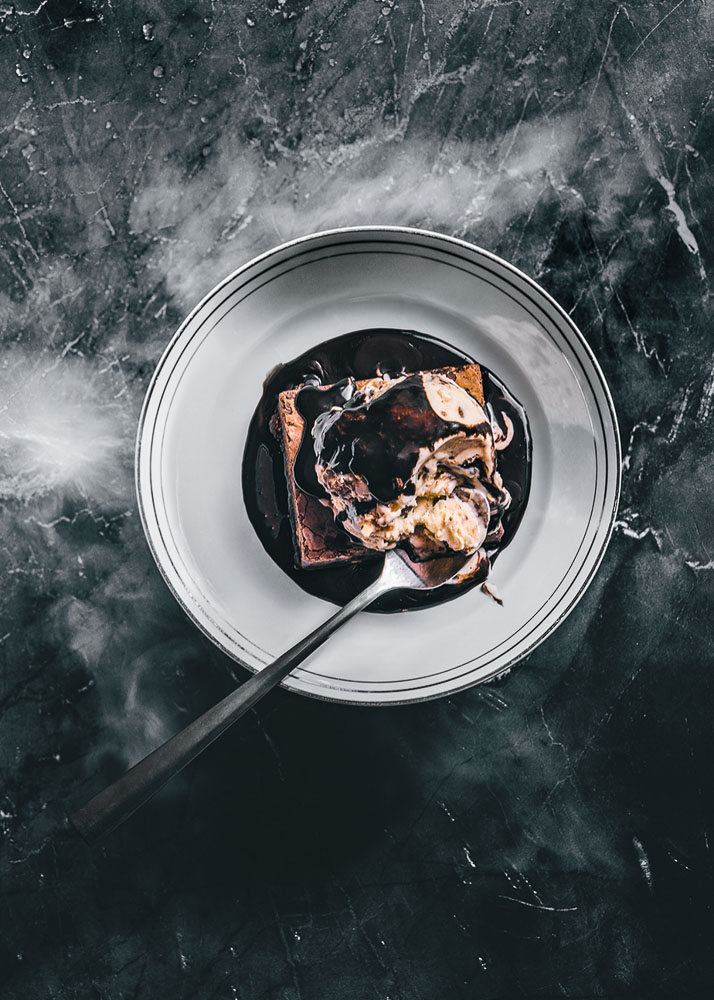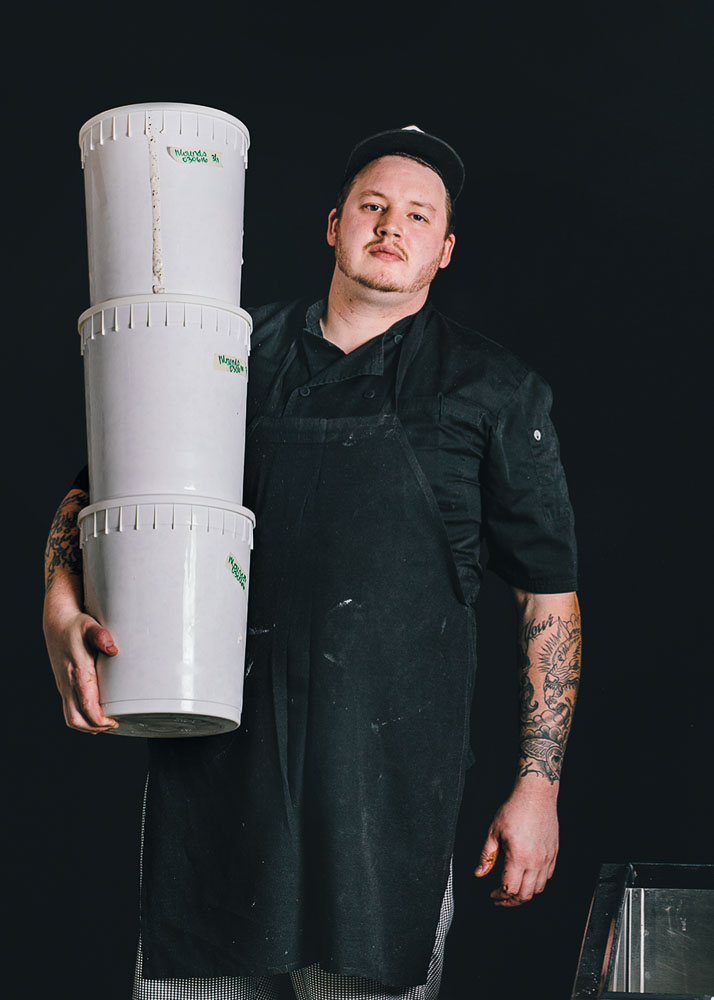Modernist Technique & An Old-Fashioned Ice Cream Parlor
PHOTOS BY ADAM DETOUR
IN 1973 Steve Herrell started a revolution, mixing chopped up pieces of candy and cookies into the dense, creamy ice cream made in his funky little storefront, Steve’s Ice Cream, in Somerville.
Forty years later and 25 miles to the west, the team behind New City Microcreamery in Hudson, MA is forging its own revolution, employing liquid nitrogen—a favored technique imported from temples of modernist cuisine—to make incomparably smooth, inventively flavored ice cream in an otherwise classic parlor setting. “It’s old school and new school,” says chef Thomas Kepner.
One of the particular joys of visiting the original Steve’s was watching ice cream churning in the home-style ice-and-salt machine, which Herrell retrofitted to meet his specifications for low-air content. At New City, customers can see the ice cream being made behind a glass wall that separates the airy open kitchen from the cafe seating. While the process is dramatic—when the liquid nitrogen is added, a cloud of fog erupts from the mixer in which the ice cream is spinning—the spectacle is a “fringe benefit,” according to co-founder Jason Kleinerman. “Liquid Nitrogen adds to the process of how do you make the best ice cream. We love the fact that it’s a show, but [that’s] an afterthought,” he says.
Opened in May 2015, New City is a sibling to Rail Trail Flatbread Co., across the street. Michael Kasseris, 31, and Karim El-Gamal, 34, who met in a Babson College MBA program, opened that restaurant and bar in 2012. It quickly became integral to the community and helped drive a renaissance of downtown Hudson.
Kleinerman, 31, who grew up with Kasseris in Belmont and met El-Gamal through him, joined the Rail Trail in early 2013.
From the beginning, customers at the restaurant asked for ice cream. “About a year into the business, we started looking into the space across the street,” says Kasseris, referring to New City’s home. “At first we were going to open a small shop and serve somebody else’s product. We started learning about ice cream and coffee, and realized we had to make our own.”
Kasseris’s uncle, Nick Kasseris, owns the building that Rail Trail occupies. His father, Theodore, owns the New City building. Erected in 1894, it has housed several retail establishments, offices and apartments. The 3,500 square foot first floor was perfect for an ice cream shop. Once they settled on the building, the restaurateurs decided to offer coffee and pastry as well, expanding options for “everyone in the community. We wanted it to be an interactive space,” Kasseris explains. Elaine Stella, pastry chef here and at Rail Trail, makes all the brownies, cookies and ice cream novelties—cakes, sandwiches, pies, tarts, micro-cones—for New City and, with Kepner (also chef across the street), develops the ice cream flavors. Coffee comes from Counter Culture in Somerville, which trained the baristas. Tea is from MEM Tea Imports.
Before the partners started construction, restoring the building’s long-hidden period detail and pulling back the façade to create a front patio, they also won a bid for a liquor license. This dramatically expanded their options for ice cream flavors as well as business. In October they opened an adjacent speakeasy-bar, accessible only through New City.
From the time they decided to open New City, Kasseris, El-Gamal and Kleinerman spent two years traveling to discover features of the best ice cream and coffee shops throughout the world. Kepner examined locations closer to home. In Europe and parts of the US, they saw the beginnings of a trend toward single-serve ice cream made with liquid nitrogen, delivered to the customer immediately, when it is still essentially soft-serve consistency.
Examples in the Boston area include Churn2, which operated out of a shipping container in Cambridge for about a year before closing in fall 2014, and ‘Wiches of Boston, which makes liquid nitrogen ice cream at parties and special events. “We didn’t want to do that,” says Kleinerman. “We are passionate about making a traditional ice cream shop… It’s hard packed ice cream.”
Before joining Rail Trail, Kepner had used liquid nitrogen to make ice cream at Craigie on Main in Cambridge. “[During prep], we would make two-quart batches for service that night,” he says. “I knew somewhere that we could do it on a larger scale and make it a focal point of the way we would do things.” He just had to convince the others.
Liquid nitrogen is nitrogen in a liquid form, at -325 degrees. When used to make ice cream, it flash freezes the custard base, creating smaller ice crystals than the traditional process. The final product has a very smooth, almost velvety texture. Keeping a steady supply of the liquid gas is an expensive proposition, though (Kleinerman declined to say how expensive). So, “It took a lot of proving,” Kepner says.
For a year before New City opened, Kepner and Stella worked with 100-liter tanks of liquid nitrogen in the Rail Trail basement, creating batch after batch of ice cream. At the same time, Kasseris, El-Gamal and Kleinerman were researching dairies. They ultimately chose to work with Mapleline Farm, a family-owned operation in Hadley that pasteurizes its own milk.
While most ice cream businesses—even many “homemade” shops—use commercial bases, New City creates its multiple bases from scratch. “We get to control infusing bases with natural flavors,” explains El-Gamal. They use natural cane sugar, inverted sugar (sugar plus citric acid), and fresh fruits and herbs, local when available. They recently started working with Lettuce Be Local, a central Massachusetts food hub that represents 80 farms, to source many fresh ingredients. The formula for the best ice cream, Kleinerman says, is pretty simple: “natural product, making your own bases from scratch and using liquid nitrogen.”
Once the founders decided to move forward with liquid nitrogen, they designed the kitchen around the process. In a clockwise format, Kepner explains, stations are set up for the stages of production: make the bases, chill the bases overnight, spin the bases into ice cream, let the ice cream harden overnight.
In its first year, New City has drawn crowds from Metrowest, Boston, Worcester, western Massachusetts and New Hampshire. In peak season, lines extend out the door. People are drawn as much for menu staples like Chocolate, Vanilla, Bourbon Vanilla and Java the Heath, as they are to the rotating flavors like Hibiscus Cabernet, Chipotle Mezcal, Ritz Cracker Pie and Fennel Pistachio.
The Fennel Pistachio was a classic case of experimentation in the kitchen, Stella explains. She was at Rail Trail and noticed the refrigerator there was awash in fennel fronds. So she decided to turn them into ice cream. The result became a surprise favorite.
Kepner’s Thai Curry Roasted Garlic ice cream, inspired by the annual Gilroy Garlic Festival in California, which features garlic ice cream, was somewhat less successful. But, he says, “This is definitely a kitchen where we can come and be creative.” It’s part of the operating philosophy. “We think of ice cream like a blank canvas,” says Kleinerman. “Erase pre-conceived notions. What else can you do with ice cream?”
Creativity aside, people wouldn’t be lining up if the ice cream weren’t pretty special. I was lucky to be present for the birth of a new flavor, Tijuana Toffee Pecan, created because Keith Sullivan (Sully), of neighboring Medusa Brewing Company, had dropped off samples of its new ancho- and chipotle-chile inflected Mexican chocolate stout. It was calling out to be paired with New City’s Mexican chocolate base.
This is probably a good time to mention that New City enthusiastically embraces top-shelf liquors as ice cream ingredients. “Adding alcohol lowers the freezing point, so using that extreme cold helps develop the consistency of ice cream that we’re looking for,” Kepner explains. “We like to add alcohols to ice cream to give it that softer, smoother texture, and give it that flavor.” New City’s Rum Horchata is a delicious case in point. Tijuana Toffee Pecan is another.
Rather than ice cream machines, New City uses two commercial mixers. The large one, a 60-quart Hobart mixer that you might find in any bakery, can produce up to 36 quarts at a time. The smaller, 20-quart one, which looks a little more serious than a home stand mixer, can make 16 quarts.
Because the Tijuana Toffee Pecan is an experimental batch, Stella works in the smaller mixer. She adds the stout to the chilled base and starts the mixer on a low speed. Gradually, she begins to pour in liquid nitrogen from a 10-liter tank (called a Dewar). Immediately, the bowl disappears into a cloud of fog. At this point two things happen. One: nobody can see what’s happening in the bowl, which makes me wonder how on earth Stella can know whether to keep adding the liquid nitrogen, or how much to add. And two: a three-generation group of six sitting nearby enjoying their cups and cones is pulled, as if by magnetic force, to come see what‘s happening, the little ones pressing their chocolate-streaked faces to the glass. “This is my favorite part, the kids,” Stella says.
She is judging primarily by the sound of the machine, which tells her how thick the ice cream has become, when it is time to stop adding liquid nitrogen. When she is done, she beats in a little air. We taste the freshly spun ice cream, now the texture of the most heavenly soft-serve. It is delicious, chocolate with hints of cinnamon, slipping down easily and leaving the subtlest kick at the back of the tongue. Stella mixes in the candied pecans and house-made toffee, we taste again and she transfers what should become a new favorite flavor into three-gallon tubs to harden overnight.
Next, Kepner makes a standard, unheard of before Herrell’s day: Cookie Dough. He works in the large mixer, which is fitted with an extra blade to scrape the sides. The blade rotates in the opposite direction of the paddle, incorporating build-up from the sides of the bowl into the rapidly freezing custard.
Like Stella, Kepner’s senses are so highly attuned to his craft that he knows by sight and sound when to stop adding liquid nitrogen. He monitors the developing ice cream until it is “light, fluffy. That’s what I go for.” When the mix has reached the right consistency—it looks like a pillowy pool of whipped cream—he adds large rounded scoops of chocolate chip cookie dough. He explains that this has to be the last step so the additions don’t alter the color or flavor of the base.
Cookie Dough ice cream is every kid’s favorite, often overly sweet. Coming right from the mixer, before its deep freeze, a spoonful of New City’s Cookie Dough ice cream is like a delicious mouthful of cold, creamy cloud. Anybody could love this.
“We like to be the place people can come and try something new and trust they’re going to like it,” says Kasseris. Mission accomplished.
New City Microcreamery
newcitycreamery.com
978.333.7144
28 Main St, Hudson
This story appeared in the Spring 2016 issue.





